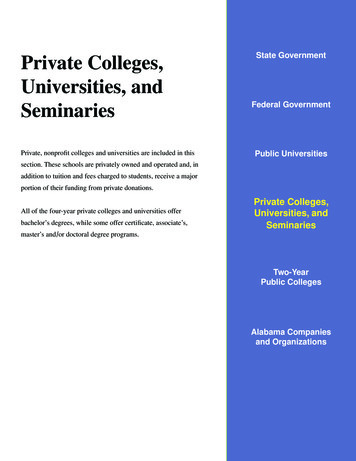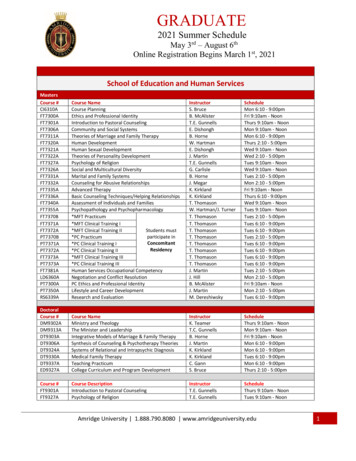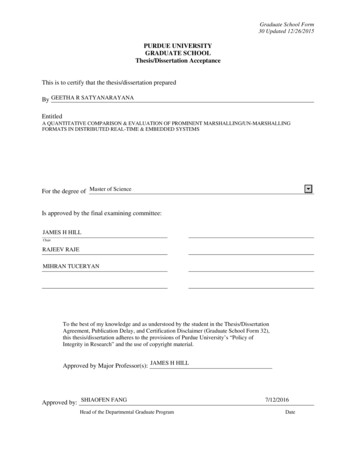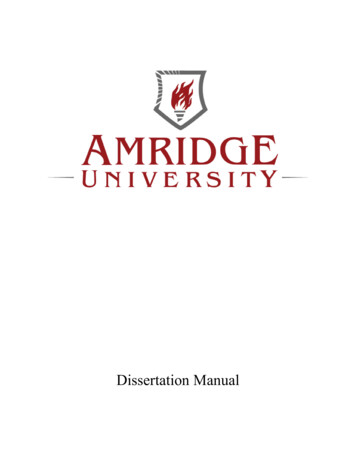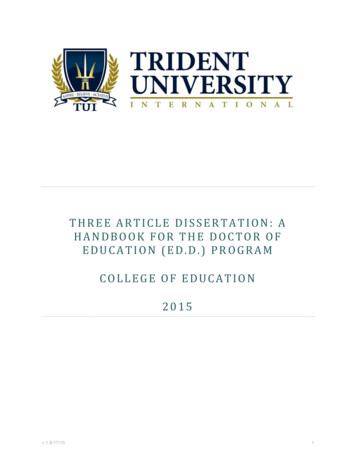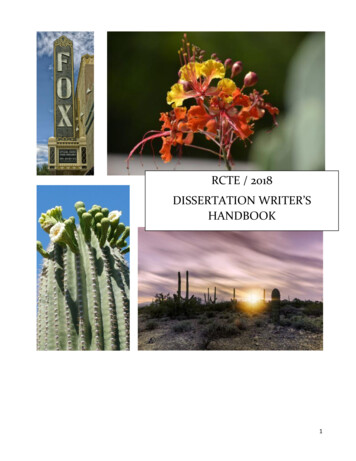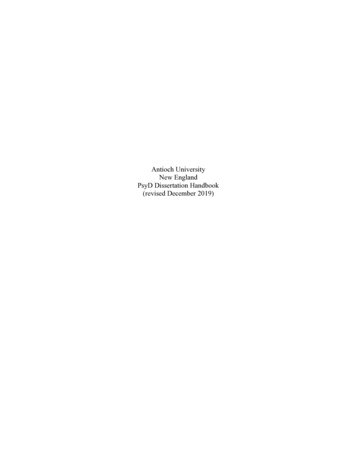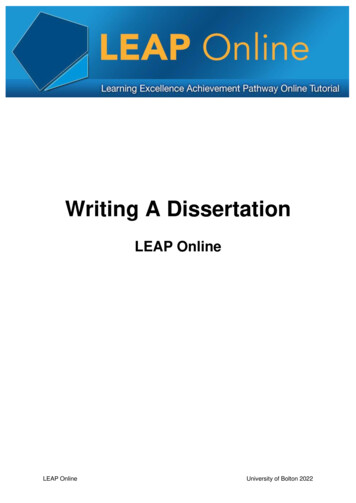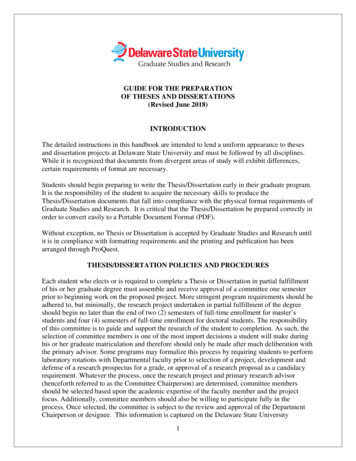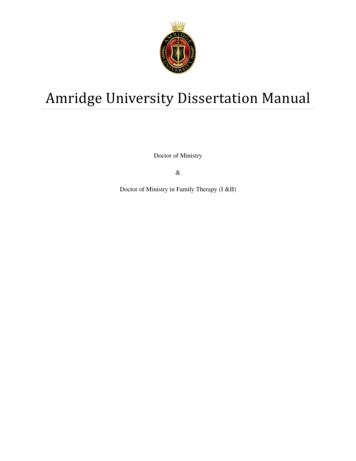
Transcription
Amridge University Dissertation ManualDoctor of Ministry&Doctor of Ministry in Family Therapy (I &II)
2Table of ContentsPurpose of the Manual . 3Introduction . 3Beginning the Dissertation . 4Dissertation Modules . 4Dissertation Committee . 4Style Manuals . 5Dissertation Guidelines . 6Topic Selection . 7Research Method and Design . 8Suggested Bibliography . 9The Dissertation Proposal . 10Review of Literature. 11Institutional Review Board . 12The Oral Defense . 13Preparing and Submitting the Dissertation . 13References . 14Appendixes. 15Appendix A: Preparing the Dissertation for Submission to the Library . 16Appendix B: Dissertation Defense Procedures . 18Appendix C: Sample Dissertation Title Page . 19
3PURPOSE OF THE MANUALPublished words become a permanent part of the public domain. Long after a student has graduated, hisor her written work continues to represent his scholarship. Therefore, what one writes becomes anoriginal contribution to the literature in one’s field of study. A student must not plagiarize or otherwisemisuse what others have written. Amridge University puts great value on research and well-writtendissertations. Like any other major university, Amridge insists that all written materials emanating fromthe University follow a uniform style.This manual provides the researcher and the dissertation committee a common basis from which toproceed in researching and writing the dissertation. One’s dissertation should demonstrate his or herknowledge of the field, ability to conduct advanced research, organizational skills, and competence inboth oral and written presentation. The dissertation should be used as a tool to ascertain and dispense truthindependent of one’s desired results.The contents of this manual are selected primarily from policies and procedures in the academic catalogand other sources. Efforts will be made to keep this manual up-to-date with University policies andrequirements. However, the user of this manual should be aware that the current Amridge UniversityAcademic Catalog is the most accurate source of University policy and, should policies in the academiccatalog differ from this manual, the policies in the catalog will take priority.In the process of writing a dissertation, the researcher may use many resources such as people withknowledge of the subject and aids such as computer software, but the student ultimately bears theresponsibility to defend his or her work and own it as intellectual property. A good dissertation enablesthe student to obtain a terminal degree -- an accomplishment which relatively few people can claim.INTRODUCTIONThe information in this manual applies specifically to students pursuing the Doctor of Ministry andDoctor of Ministry in Family Therapy (I & II) degree programs. Candidates and faculty members shouldbe familiar with the contents of this manual, as it contains key information regarding the expectations andcomponents of the DMin dissertation. It is important to note that the DMin dissertation differs from thatof a PhD dissertation. While the PhD dissertation focuses on making a new contribution to the body ofknowledge in one’s field, the DMin dissertation focuses on making a practical contribution within thefield of ministry. The PhD dissertation may focus on generating a new theory or testing an existingtheory; however, the DMin dissertation would typically focus on the practical application of an existingtheory in response to a problem the student has identified within the context of his or her ministry.The doctoral dissertation at Amridge University is a formal, written document that is accepted for partialfulfillment of a doctoral degree program. The doctoral dissertation demonstrates the student’s ability to:1.2.3.4.5.Analyze and synthesize the pertinent literature on a subjectIdentify, select and verbalize a valid, researchable problemDesign and implement a scientific investigationAnalyze the results of the investigation and draw supported conclusionsDevelop a written report of the study that meets standards of the profession and present practicalinformation to professionals in the field
4BEGINNING THE DISSERTATIONThe student must pass his or her Qualifying Exam and achieve “Candidacy Status” prior to enrolling inthe first Dissertation Module. Candidacy Status marks a major milestone in one’s doctoral journey andrepresents the transition from student to independent researcher. Before beginning the dissertation thestudent should have a general understanding of the dissertation purpose, standards and requiredprocedures. The student must be eligible to begin the dissertation and must have a dissertation committeeappointed. The student must develop the dissertation through a series of dissertation module courses andmust receive approval from the Institutional Review Board prior to beginning data collection.DISSERTATION MODULESThe DMin dissertation is to be completed through a sequence of three dissertation module courses. Thesequence may also include module continuation courses. A Research Dissertation Module - FirstContinuation course and a Research Dissertation Module - Second Continuation course are available foreach module course level if the student does not complete all requirements for a given module in onesemester.The student must successfully complete the dissertation modules in sequence. The student must receive agrade of P (Pass) for a module course (either the original module course or the first continuation modulecourse or the second continuation module course) to be eligible to enroll in the next level module coursein the sequence. After beginning the dissertation the student must enroll in a dissertation module course ordissertation module continuation course each semester until completion of the dissertation.DISSERTATION COMMITTEEThe dissertation is developed by the student with the advice, guidance and approval of the dissertationcommittee. The dissertation committee is composed of the student, a chairperson, one or more readers,and the dissertation secretary. The dissertation committee is appointed by the Dean of the school andapproved by the Vice President of Academic Affairs. The student is responsible for requesting that theDean appoint the dissertation committee. The student, in consultation with the Dean, may request thatspecific individuals be appointed as chairperson or as dissertation reader.Student - The student is responsible for his or her dissertation. This includes registering for the correctdissertation course, selecting the dissertation topic, conducting the literature review, designing theresearch plan, obtaining necessary approvals, executing the research plan, writing the dissertation,obtaining approval for each module, defending the dissertation, and fulfilling all dissertationcompletion processes.Chairperson - The dissertation chairperson is the leader and coordinator of the dissertationcommittee. The dissertation chairperson provides advice and reactions to the student’s ideas andmaterials. The dissertation chairperson communicates to the students the directions and decisions ofthe committee. The dissertation chairperson considers both the technical content and the written formof the student’s presentations. The dissertation chairperson decides when to bring in the dissertationreader for suggestions and reactions during the planning and development stages.
5Reader - The dissertation reader reads, evaluates, and provides written reactions to each dissertationmodule as it is presented. The dissertation reader provides assessment and advice regarding subjectmatter content.Secretary - The dissertation secretary is responsible for assessing the quality of the written productbased on standards of grammar, sentence structure, and the appropriate writing style manual. Thedissertation secretary checks each dissertation module against University standards. The dissertationsecretary provides ideas and reactions when requested by the dissertation chairperson.STYLE MANUALSThe Turner School of Theology and the School of Human Services at Amridge University require studentsto follow different style manuals. Students enrolled in the Doctor of Ministry degree program are required to use the writingguidelines provided in the latest edition of the Chicago Manual of Style (CMS Manual).Students enrolled in the Doctor of Ministry in Family Therapy (I & II) are required to use thewriting guidelines provided in the latest edition of the Publication Manual of the AmericanPsychological Association (APA Manual).It is the student’s responsibility to become familiar with the appropriate manual and ensure that anyoneassisting in the typing of the document follows the rules of the manual. The manuals also includedirections for the reporting of numbers, construction of tables and figures, structure of headings, use ofsexist terms, preferred language, and the expression of ideas or writing style suggestions. Writing forresearch or publication demands a new level of dedication and compliance to rules, and, in order to beacceptable by publishers of professional literature, the student must demonstrate this ability. Thecommittee must be able to focus on the substantive content of the dissertation without spending valuabletime looking for infractions of these rules.Allowable alternatives/exceptions to the University approved Style Manuals: If a student is writing a paper for publication, the student is allowed to follow the editorialguidelines of the publication rather than the school approved style manual.A student may choose whether to use one or two spaces after a period, as long as consistency ismaintained.The possessive of Jesus may be done as Jesus’ or Jesus’s, according to the student’s preference.Pronouns for religious figures, including God and Jesus as deity (e.g. he, him, and his), may beeither upper case or lower case, as long as consistency is maintained. In quotations of works byother authors, the integrity of sources must be maintained by preserving either upper or lowercase pronouns for deity as found in the original sources.
6DISSERTATION GUIDELINESDoctor of Ministry students are strongly encouraged to follow the traditional dissertation format, whichconsists of five chapters. This format is most common; however, variations exist. The candidates shouldconsult with his or her dissertation committee to determine the most appropriate format withconsideration given to the chosen approach.A suggested template is given below for students to consider along with advice from their committeechairpersons. General, suggested guidelines for page numbers are included as well. Chapters may varyslightly by name and/or page length as a result of the chosen research method and design. For example, ifa student puts most of the research results and findings in an appendix, Chapter 4 might be quite short. Ifthe data is quite extensive and if it is all reported in Chapter 4 rather than an appendix, Chapter 4 couldexceed 30 pages.The quality of the work is what is most important, not the actual length of the dissertation or eachindividual chapter. Listen to the advice of your chairperson and the other committee members as theyjudge your unique topic and the research needed to address your research problem and questions in theproper manner.5 Chapter Dissertation GuidelinesChapter 1 - Introduction (12 -15 pages)The introductory chapter generally includes the following key sections: Need for the Study, Statementof the Problem, Purpose of the Study, Delimitations, and Definitions of Key Terms.Chapter 2 - Review of Literature (25 - 40 pages)In the Review of Literature, the candidate should summarize and synthesize the peer-reviewedliterature relevant to the topic area of the dissertation. Findings from existing studies should not bemerely reported; they should be compared and contrasted when appropriate.Chapter 3 - Research Method (15 - 20 pages)Discuss the appropriateness of the research method as it relates to the problem statement, and presentthe research design chosen for the study. Provide enough details so that the study could be replicated.Chapter 4 - Reporting of Data (15 - 30 pages)Present and evaluate the findings in light of the research questions.Chapter 5 - Conclusions and Recommendations (15 - 30 pages)Draw conclusions based on the findings presented in Chapter 4. Discuss practical implicationsresulting from the conclusions.
7TOPIC SELECTIONSelecting a topic for researching and writing a dissertation is one of the most important decisions one canmake in a doctoral program. Do not rush and make a quick, hasty decision on a dissertation topic. Rather,make a cautious, careful, deliberate decision in the choosing of a topic, and the rest of your work inresearch, gathering data, analysis, writing, and defense will go much smoother and be more pleasant.A DMin dissertation topic should match the personal and vocational goals of the candidate. In otherwords, a good topic will typically have some relationship to the candidate’s career goals and related to hisor her current vocational setting. For a candidate in the Doctor of Ministry degree program, thedissertation may involve a ministry project related to the student’s present work in ministry (e.g.missions, preaching, chaplaincy, etc.). For a candidate in the Doctor of Ministry in Family Therapy degreeprogram, the dissertation may involve a counseling or family therapy technique or an intervention fordealing with addictions. Further, the DMin dissertation must match the candidate’s academic needs andgoals for whichever field in which he or she is studying.There are many ways you can go about selecting a topic (Neuman, 2006). Begin by exploring ideas fromyour personal experience in ministry, counseling, or family therapy and examining current cultural trendsthat affect your field. The current state of knowledge in your field of study will yield many topics that arevalid for research. In reviewing your vocational specialty, consider the problems people often strugglewith. Also consider the values to which you are committed – religiously, socially, ethically, andpolitically – and explore how a topic might be embedded in these aspects. You should also seek advicefrom professors and scholars for areas of study that need to be explored further (Lei, 2009) and explorerecommendations for further research in recently published peer-reviewed journals. As you continue tonarrow your topic, consider the following questions:1. Is it WORTHY? Choose a topic that merits the time and effort of dissertation research. It couldtake two or three years to complete your project, so you need to choose a topic worthy of thatcommitment. By the way, it is a myth that you must pick a topic that you are passionate about orone to which you have a prior commitment (Ségol, 2014).2. Is it FEASIBLE? Pick a topic that is manageable. Be realistic. Consider the resources that will beneeded, the participants that will potentially be involved, and the time that will be required.3. Is it RELEVANT? Select a topic that is timely; it should matter to and make a difference in yourfield now and in the future. Strive to make your dissertation of publishable quality, and think of itas a way to make a positive impact on others and advance your career. Those things are morelikely to occur when your topic is relevant.Once you have found a topic that you think is perfect for you, your academic goals, and your vocationalgoals in ministry, counseling, or family therapy, further groundwork is still needed. Search thedissertation index for other dissertations on this topic to see what others have written. Remember, yourdissertation needs to be original work. If other dissertations exist on a similar topic, read their abstracts tosee if they are cast in a different ministry setting or if they tackle a somewhat different problem. You wantto make sure that your dissertation proposal will be unique. You should also do a bibliographical surveyof books and journal articles to ensure there is sufficient literature available for your literature review.Finally, confer with the instructor who has the most expertise within your topic area, since that instructorwould be the most likely person to be the chairperson for your dissertation committee. Get advice fromhim or her on the suitability of your topic. Find an advisor who is knowledgeable about your dissertationtopic and is able to help you analyze it for potential issues, problems or dangers. Try to choose an advisorwith whom you think you will have a good working relationship (McKinley, Grant, Middleton, Irwin, &Williams, 2009).
8RESEARCH METHOD AND DESIGNAs noted in the Introduction, the DMin dissertation is an applied research project. In an applied researchproject, the researcher typically seeks to understand a human or societal problem and develop anintervention that allows him or her to manage his environment more effectively (Patton, 2002). Further,an emphasis is placed on the application of existing theory and disciplinary knowledge as the researcherstrives to understand the complexities of the problem being addressed.Considering the nature and scope of the DMin dissertation, Amridge University often encourages DMinstudents to choose a qualitative design because this method of inquiry provides a flexible structure forexploring problems as they exist in the everyday world (Creswell, 2007). In a qualitative study, theresearcher examines characteristics, nuances and complexities in order to understand a situation (Leedy &Ormrod, 2010). After developing a thorough understanding of a problem within the context of his or herministry or counseling/therapy setting, the DMin researcher can then determine ways to more effectivelyfacilitate that environment.Below is a list of recommended research designs for the DMin dissertation.1. Program Development and Evaluation: Develop and implement a ministry initiative orcounseling/therapy program and evaluate its effectiveness. Develop a curriculum for adults to promote the practice of spiritual disciplines; the student wouldselect a few classes or groups to study and act on the curriculum. Create a leadership development course to train future church leaders to assume a place in churchleadership. Produce a program (curriculum) for training teenagers to lead in various areas of worship. Teach a particular leadership theory to see how it raises the level of effectiveness of leaders in achurch setting. Create a marriage enhancement curriculum or program to increase marital satisfaction within aspecific group.2. Program or Process Evaluation: Examine and evaluate the effectiveness of an existing program orprocess in an effort to make improvements and enhancements based on the research findings. Evaluate the assimilation program used by a church to involve and retain new members. Evaluate an addiction recovery program to ascertain sustained recovery among participants over agiven period. Evaluate a church pre-school program to ascertain whether new families joined the churchthrough their participation in the program.3. Case Study: Select a case (e.g. church, organization, church leader, community, event, etc.) and studyit in-depth over a period of time. The researcher may describe a relationship or system, attempt to verifyan assumption, or evaluate a policy, practice, or innovation. Case studies have become quite common inthe social sciences, and this approach can be especially useful in understanding unique ministry andcounseling/therapy settings. While a single case study is typically chosen to generate an in-depthunderstanding of a specific setting or situation, the researcher may choose to conduct a multiple casestudy in order to generate broader generalizations to inform practice.
9 Evaluate the use of temporary facilities by churches in a location transition for meeting ministryobjectives (perhaps studying four churches that have used temporary facilities to move from onepermanent location to another).Examine and evaluate churches within a religious group in a particular region of the country whohave reached and maintained a membership of over 400 for 10 years or more.Evaluate the leadership structure of five churches that have been listed as healthy churches in anationwide church or denominational newspaper to determine shared characteristics.Evaluate the growth patterns of church plants that meet in rented, temporary facilities versusthose who meet in owned, permanent facilities.Selecting an appropriate and acceptable research method and design is critical to the success of the DMindissertation. Students are encouraged to explore the resources in the Suggested Bibliography below andconsult with faculty regarding these decisions.SUGGESTED BIBLIOGRAPHYAuerbach, C. F. & Silverstein, L. B. (2003). Qualitative data: An introduction to coding and analysis.New York: New York University Press.Creswell, J. W. (2009). Research design: Qualitative, quantitative, and mixed methods approaches.Thousand Oaks, CA: Sage Publications.Creswell, J. W. (2007). Qualitative inquiry and research design: Choosing among five approaches.Thousand Oaks, CA: Sage Publications.Leedy, P. D., & Ormrod, J. E. (2016). Practical research: Planning and design (11th ed.). Saddle River,NJ: Merrill.Patton, M. Q. (2002). Qualitative research & evaluation methods (3rd ed.). Thousand Oaks, CA: SagePublications.Sensing, T. (2011). Qualitative research: A multi-methods approach to projects for doctor of ministrytheses. Eugene, OR: Wipf and Stock.Shank, G.D. (2006). Qualitative research: A personal skills approach (2nd ed.). Upper Saddle River, NJ:Pearson Education, Inc.The Chicago Manual of Style Sixteenth Edition. (2010). Chicago: The University of Chicago Press.Vyhmeister, N. J., & Robertson, T. (2014). Your guide to writing quality researchpapers for students of religion and theology. Grand Rapids: Zondervan.Yin, R. K. (2014). Case study research: Design and methods (5th ed.). Thousand Oaks, CA: SagePublications.
10THE DISSERTATION PROPOSALThe dissertation proposal provides the foundation for the research plan and serves as the candidate’sroadmap to completion of the dissertation. The dissertation proposal contains many of the keycomponents of Chapter 1 of the dissertation. It also organizes the project, and the effort and clarity putforth in the proposal will likely prevent problems down the road and help the candidate avoid pitfalls thatcommonly occur in subsequent stages of the dissertation process.Components of the Proposal: While some of the components may vary slightly in the order and lengthof presentation, each proposal will contain, but is not limited to, the following: Introduction Describe the congregational or counseling/family therapy setting and structure Provide the main ideas and establish the central focus of the study Present the key concepts that will be discussed throughout the studyStatement of the Problem Clearly articulate the problem that the study will address Be succinct, but justify the need for the studyPurpose of the Study Describe the overall goal of the study Provide an overview of how the goal will be achievedResearch Question Provide context for the reader by briefly reintroducing the problem and main ideas Propose answerable research questions that are aligned with the problem and purposeDelimitations Define the boundaries of your proposed study Describe the scope as it relates to the research design you have chosenDefinition of Key Terms Define the key terms and concepts that will be discussed in the study Support definitions with citations It is typically not necessary to define terms that are commonly knownBrief Review of Literature Synthesize and evaluate the most relevant existing scholarly literature Discuss conflicting findings/points of view (if any) in the existing literatureResearch Methodology Present the rationale for the research method and design Explain why the selected method and design are most appropriate for the problem,purpose, and research questions Provide and justify the approximate sample sizeConclusion Summarize the key points presented in the document Present an outline for the remainder of the projectNOTE: It is important to align the problem, purpose, research questions, and proposed design perfectly.
11REVIEW OF LITERATUREThe literature review is the chapter of the dissertation in which the researcher critically analyzes andsynthesizes existing literature related to the dissertation topic. Some literature reviews flowchronologically; they begin with germinal works and move forward with more recent seminal works.Most DMin literature reviews, however, survey relevant literature by theme or topic.The literature review can accomplish numerous objectives. For example, it may: Further establish the significance of the research project;Detail the history of research published in the topic area;Compare and contrast opposing points of view in the topic area;Discuss theoretical/conceptual frameworks commonly utilized in similar contexts;Present empirical data and evaluate conclusions from existing studies; and/orHighlight variables to be measured, noteworthy themes in the literature, or gaps ofinformation that need to be filled (Sumerson, 2014).So what are the characteristics of an acceptable literature review?First and foremost, the literature review must flow logically and be well organized. It is important tobegin the chapter with an introduction that explains both the purpose and the organization of the chapter.In the introduction, the researcher should also reveal where sources were retrieved from (e.g. the libraryor online library search engines) and describe the strategy used in the search for sources. The chaptershould be organized by themes and sub-themes, and a succinct summary of the key points (two to threeparagraphs) should be provided in conclusion.Second, the literature review must exhibit adequate coverage (Holbrook, Bourke, Fairbaim, & Lovat,2007). One’s research must be thorough and extensive in its review of relevant academic, scholarly booksand peer-reviewed journal articles. Depending on the nature of the research problem, other types ofsources may have to be sought out and investigated. If opposing or alternative perspectives exist in thetopic area, those viewpoints should be included and analyzed carefully in order to demonstrate unbiasedresearch.Third, the researcher must make coherent use of sources (Holbrook et al., 2007). Sources should bechosen, analyzed, and arranged in a manner so that they are used appropriately and advance the argument.Scholars should not be quoted simply because they are scholars. Instead, appeals should be made tological arguments or other evidence to be offered for or against a proposition.Finally, the review of literature should be substantive (Holbrook et al., 2007). The researcher should befamiliar enough with the relevant literature so that he or she has a practical understanding of it. Theresearcher should be able to review the relevant literature in depth, analyze it critically, and give it asystematic treatment. The goal is that the researcher will be able to make appropriate connections betweenfindings in the literature review and what is discovered in his or her own research project (Holbrook et al.,2007). Topic selection is critical. For example, a topic that is too broad will make an in-depth review ofliterature impossible.
12INSTITUTIONAL R
5 Reader - The dissertation reader reads, evaluates, and provides written reactions to each dissertation module as it is presented. The dissertation reader provides assessment and advice regarding subject matter content. Secretary - The dissertation secretary is responsible for assessing the quality of the written product based on standards of grammar, sentence structure, and the appropriate .
